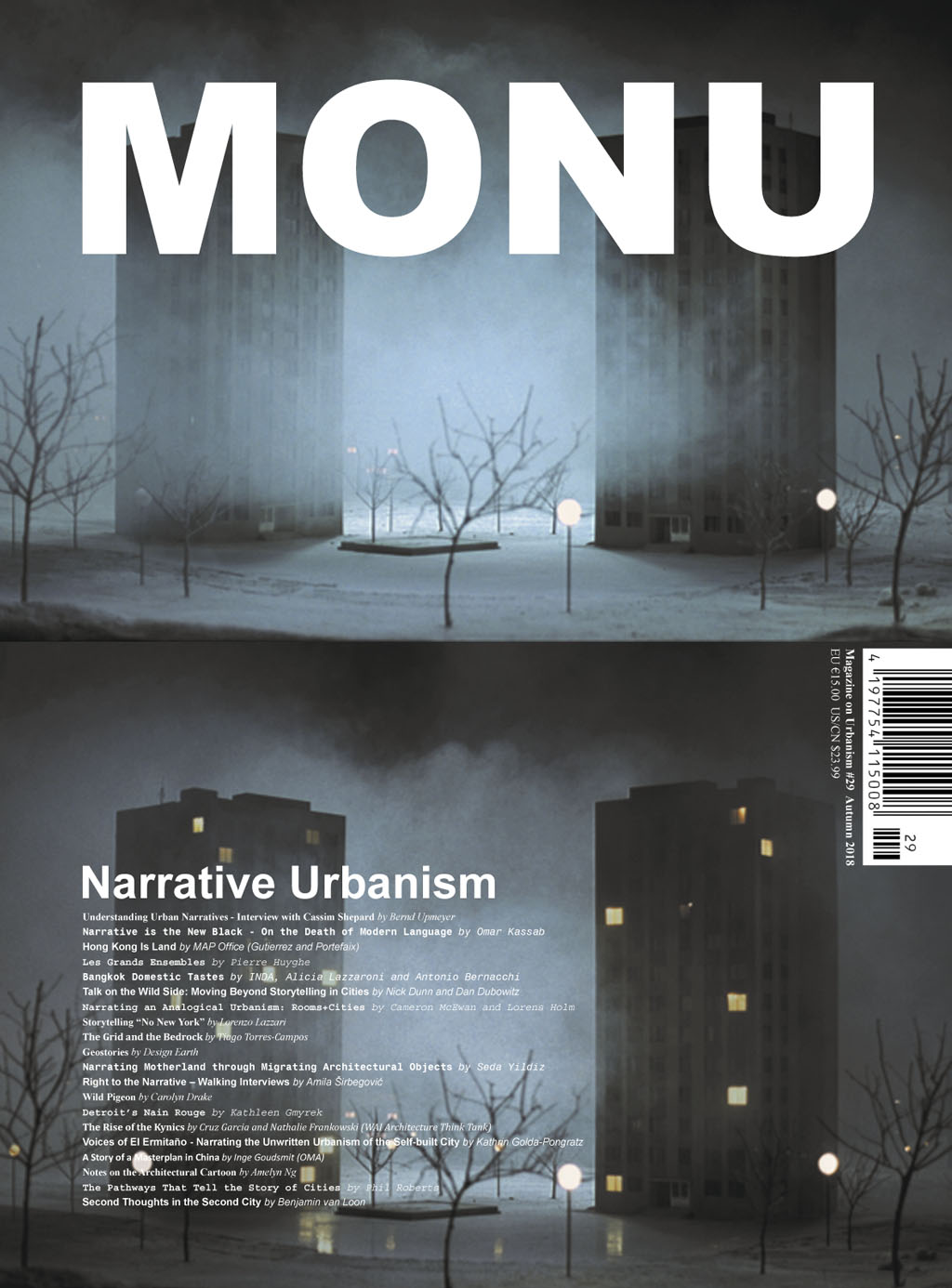15-10-18 // MONU #29 – NARRATIVE URBANISM

(browse the entire issue #29 on Youtube)
Understanding Urban Narratives – Interview with Cassim Shepard by Bernd Upmeyer; Narrative is the New Black – On the Death of Modern Language by Omar Kassab; Hong Kong Is Land by MAP Office (Gutierrez and Portefaix); Les Grands Ensembles by Pierre Huyghe; Bangkok Domestic Tastes by INDA, Alicia Lazzaroni and Antonio Bernacchi; Talk on the Wild Side: Moving Beyond Storytelling in Cities by Nick Dunn and Dan Dubowitz; Narrating an Analogical Urbanism: Rooms+Cities by Cameron McEwan and Lorens Holm; Storytelling “No New York” by Lorenzo Lazzari; The Grid and the Bedrock by Tiago Torres-Campos; Geostories by Design Earth; Narrating Motherland through Migrating Architectural Objects by Seda Yildiz; Right to the Narrative – Walking Interviews by Amila Širbegovic; Wild Pigeon by Carolyn Drake; Detroit’s Nain Rouge by Kathleen Gmyrek; The Rise of the Kynics by Cruz Garcia and Nathalie Frankowski (WAI Architecture Think Tank); Voices of El Ermitaño – Narrating the Unwritten Urbanism of the Self-built City by Kathrin Golda-Pongratz; A Story of a Masterplan in China by Inge Goudsmit (OMA); Notes on the Architectural Cartoon by Amelyn Ng; The Pathways That Tell the Story of Cities by Phil Roberts; Second Thoughts in the Second City by Benjamin van Loon
To create a better general culture of understanding around architecture, urban design and urban development issues, we need to use all of the narrative tools that we have at our disposal, claims Cassim Shepard in the interview we did with him entitled “Understanding Urban Narratives: What Cannot be Measured” for this new issue of MONU, “Narrative Urbanism”. Being a filmmaker, he points out that moving images in this day and age are particularly effective forms of communication as they have the capacity to make people want to engage. For him, filmmaking is a very useful process that taught him how to talk to people, how to listen to people, how to observe spaces critically and with an open mind, in order to understand the unique urban dynamics that make every space special and worthy of care. Without that extra attention many things in our cities can simply be forgotten. With his contribution “Les Grands Ensembles” – a video still of a film depicting model replicas of two modernist high rise buildings in a barren nocturnal landscape in the suburbs of Paris – the French artist Pierre Huyghe attempts to fight such urban amnesia by representing a period that has remained marginalized and overlooked. In order to bring forth latent stories and revelations of places and to contribute to the poetics of future city making through narratives that are often overlooked or excluded, Nick Dunn and Dan Dubowitz suggest in their article “Talk on the Wild Side: Moving Beyond Storytelling in Cities” collective walks through lost parts of cities. In that way one important aspect of Narrative Urbanism can be understood as the effort to make the invisible visible and as a discourse concerning the ‘common’ of the community, as Lorenzo Lazzari emphasizes in his piece “Storytelling “No New York””, depicting narratives as complex operations, and the result of the union of several parts, that require the consideration of diverse aspects of cities. Following Amila Širbegovic in her contribution “Right to the Narrative”, Narrative Urbanism thus has the potential to make on the one hand observable the stories of the unheard and the unseen, and on the other hand to create the possibility for architects, urban designers, and city planners to participate in – but also to question and to transform – the conditions of urban sites into which they intervene in their future practice. How to observe the stories of the people and involve them into creative processes, is demonstrated by the American photographer Carolyn Drake in her photo-essay “Wild Pigeon”, for which she traveled through the Xinjiang Uyghur Autonomous Region in China, around 3.000 km from Beijing, with a box of prints, a pair of scissors, coloured pencils, and a sketchbook, asking willing collaborators to draw on, reassemble, and use their own tools on her photographs. And once non-experts are involved in creative processes and the shaping of cities, the urban dynamics can change, which leads – according to Kathleen Gmyrek – to participatory narratives, as she argues in her piece “Detroit’s Nain Rouge”, in which she explains how a myth around a red dwarf known as the Nain Rouge, that inspired a parade in the city of Detroit, offers a public forum for participants to grapple with the political and socioeconomic forces that are shaping the city’s future, providing the opportunity to play an active role in framing the narrative of their city. However, since architects are great storytellers too, as Inge Goudsmit from the Office for Metropolitan Architecture (OMA) reminds us in her contribution “A Story of a Masterplan in China”, they will remain – together with everybody else involved in the creation of cities – obliged to make themselves understood better, using the power of “narratives” to help them to connect not only to experts and intellectuals in the field, but to everybody else too. But as Cassim Shepard clarifies, such “expert” narratives should not merely be used to get communities to agree to new urban developments. What he believes is more important, is to try to bring narrative strategies into the way we understand the complexity of a site from the very beginning, and then throughout the project analyze and interpret and develop what the project is about. For, as Benjamin van Loon points out in his article on the city of Chicago entitled “Second Thoughts in the Second City”, only through honest storytelling can design make a difference, because if it weren’t for storytelling, would cities exist at all?
Bernd Upmeyer, Editor-in-Chief, October 2018
(Cover: Image is part of Pierre Huyghe’s contribution “Les Grands Ensembles” on page 25. ©Marian Goodman Gallery Paris/New York)
Find out more about this issue on MONU’s website.